Did you know Dachshunds are 11 to 12 times more likely to get intervertebral disc disease (IVDD) than other dogs? This fact shows how special these dogs are. Their long bodies and short legs have won many hearts. Let’s explore the amazing world of Dachshund appearance and their unique body structure.
Dachshunds come in two main sizes: standard and miniature. Standard Dachshunds weigh 16 to 32 pounds. Miniatures weigh 11 pounds or less. They have three coat types: smooth, wirehaired, and longhaired. Each needs different care.
It’s important to keep Dachshunds at a healthy weight. They can easily get too fat, which worsens their back issues. To keep them healthy, they need regular exercise and a good diet. This helps them live their 12 to 15-year average life to the fullest.
Key Takeaways
- Dachshunds have a unique long body and short leg structure
- They come in standard and miniature sizes
- Three coat varieties: smooth, wirehaired, and longhaired
- Prone to IVDD due to their body shape
- Average lifespan of 12-15 years
- Require regular exercise and a balanced diet
Introduction to the Dachshund Breed
The Dachshund is a beloved dog breed with a rich history. They have captivated dog lovers for centuries. Known for their unique body shape and spirited personalities, they have a fascinating background.
Origin and History
The dachshund breed history goes back to 15th-century medieval Europe. Germany played a key role in their development. The name “Dachshund” means “badger dog” in German, showing their original purpose.
These pups were bred as badger hunting dogs. They were designed to fearlessly pursue their prey into underground burrows.
Breed Purpose
Dachshunds were bred as hunting companions. Their long, low bodies and strong paws were perfect for digging and navigating tight spaces. They excelled at badger hunting and other burrowing animals.
Today, dachshund breed standards still reflect their hunting origins. Even though they’ve become beloved family pets, their hunting roots remain.
Popularity
The Dachshund’s popularity soared in the 1800s, especially in Great Britain. They became popular house pets. Their charm and unique appearance have won hearts worldwide.
In the United States, Dachshunds rank sixth in popularity among dog breeds. This shows their enduring appeal.
| Characteristic | Standard Dachshund | Miniature Dachshund |
|---|---|---|
| Height | 8-9 inches | 5-6 inches |
| Weight | 16-32 pounds | Up to 11 pounds |
| Lifespan | 12-16 years | 12-16 years |
Dachshunds offer a delightful blend of charm and character. Their distinctive looks and spirited personalities continue to win hearts worldwide.
Dachshund Size Variations
Dachshunds come in different sizes, each with its own charm. Knowing about these sizes can help you pick the right dog for you.
Standard Dachshunds
Standard dachshunds are bigger, weighing 16 to 32 pounds. They are about 8 to 9 inches tall at the shoulder. Their long bodies and short legs make them easy to spot.
Miniature Dachshunds
Miniature dachshunds are smaller, weighing 11 pounds or less. They grow to be 5 to 6 inches tall. Despite their size, they have big personalities.
Rabbit Dachshunds
In some places, there’s a third size: the Rabbit Dachshund. These tiny dogs weigh 4 to 8 pounds and are 4 to 6 inches tall. They’re loved for their small size, even if not recognized everywhere.
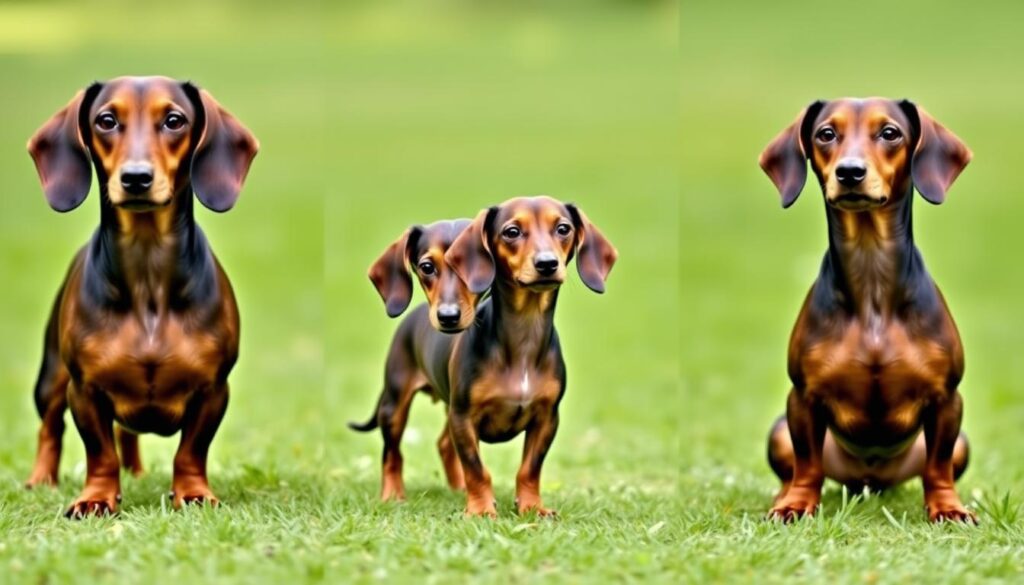
| Size | Weight (lbs) | Height (inches) |
|---|---|---|
| Standard Dachshund | 16-32 | 8-9 |
| Miniature Dachshund | 11 or less | 5-6 |
| Rabbit Dachshund | 4-8 | 4-6 |
All dachshunds, no matter the size, are friendly and have a unique look. Whether you like a standard or miniature dachshund, they are great friends.
Distinctive Body Structure
The dachshund body shape is truly unique. These dogs have a long body and short legs, making them stand out. Their shape was designed for burrowing into tunnels to hunt badgers and other small animals.
Dachshund proportions are quite remarkable. Their long bodies help them move through narrow underground passages easily. The short legs, though funny-looking, are important. They help these dogs dig well and stay stable in tight spaces.
A dachshund’s chest is deep and well-sprung. This houses a big heart and lungs. It gives them the stamina needed for their original hunting duties. Despite their small size, dachshunds are surprisingly muscular and strong.
| Feature | Purpose |
|---|---|
| Long body | Maneuvering through tunnels |
| Short legs | Digging and stability |
| Deep chest | Housing large heart and lungs |
While their body structure makes them excellent burrowers, it can also lead to health concerns. The elongated spine puts dachshunds at risk for intervertebral disc disease. As a dachshund owner, you should be mindful of this and take steps to protect your pet’s back health.
Dachshund Coat Types
Dachshunds have three coat types, each with its own charm and grooming needs. These varieties make them versatile and appealing. They fit different lifestyles and preferences well.
Smooth-Haired
The smooth coat dachshund has a sleek, shiny look. Its short coat needs little grooming, perfect for those with busy lives. They shed a bit but are easy to care for.
Long-Haired
Longhaired dachshunds have a flowing coat that looks elegant. Their hair is sleek and wavy, needing daily brushing to avoid tangles. They shed more but have a softer texture.
Wire-Haired
The wire-haired coat is thick and wiry. These dachshunds have bushy eyebrows and a charming beard. They need regular brushing and occasional hand-stripping for their coat.
| Coat Type | Grooming Needs | Shedding Level | Texture |
|---|---|---|---|
| Smooth coat | Low | Occasional | Short, shiny |
| Longhaired coat | High | Moderate | Sleek, wavy |
| Wire-haired coat | Medium | Low | Rough, wiry |
Dachshunds are active and smart, needing regular exercise and mental play. With the right care, their coat will stay beautiful and healthy. It will show off their lively personality.
Colors and Patterns
Dachshund colors and patterns are truly stunning. These cute dogs come in many shades and combinations. Each one is unique, with solid colors and eye-catching patterns.
The American Kennel Club lists 12 standard dachshund colors. Red and cream are among them, with red being the most common. Cream dachshunds look a bit like Golden Retrievers.
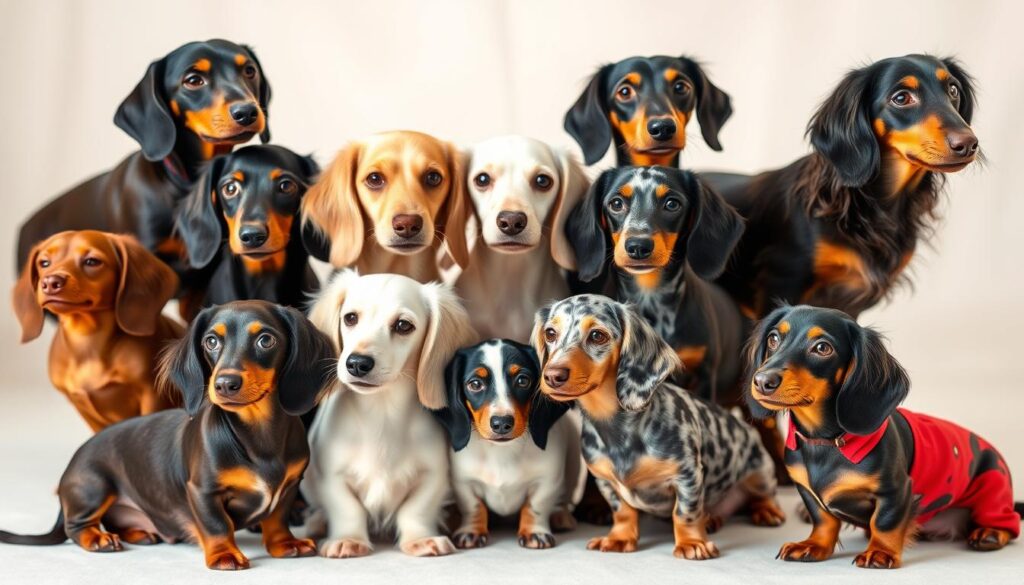
Two-colored dachshunds include black and tan, and chocolate and tan. They often have hazel or light brown eyes. Dilute genes can change black to blue and chocolate to Isabella, adding more colors.
Dachshund coloring patterns make them even more special. They can have dapple, brindle, sable, or piebald patterns. Wheaten dachshunds look like terriers because of their breeding history.
| Coat Type | Genetic Dominance | Inheritance Chance |
|---|---|---|
| Wire | Dominant to all | Varies |
| Smooth | Dominant to Long | 25% per puppy |
| Long | Recessive to both | Varies |
The genetics behind dachshund coat colors are fascinating. They have 39 chromosome pairs, with at least 7 gene pairs controlling coat color. This complex genetic makeup results in the wide range of dachshund colors and patterns we adore.
Dachshund Physical Characteristics
Dachshunds have a unique body shape that makes them stand out. They are small but full of character. Let’s look at what makes them special. Dachshunds have a long, low body with short legs, giving them a distinct appearance. Despite their small stature, they are quite muscular and agile. Dachshund Exercise is important to maintain their physical health and prevent obesity, as they are prone to back problems. Regular walks and playtime can help keep these lively little dogs in top form.
Long Body and Short Legs
Dachshunds are known for their long bodies and short legs. This makes them look low to the ground. Their body is usually 1.5 to 2 times their shoulder height.
This shape helps them fit into tight spaces. It’s a trait from their days as badger hunters.
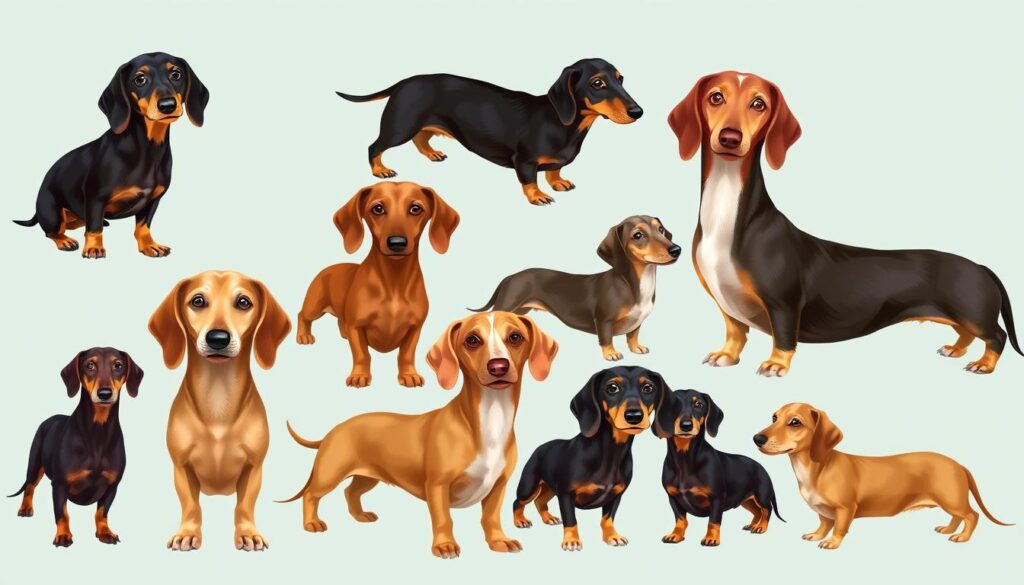
Chest Depth and Rib Cage Structure
Dachshunds have a deep chest and a barrel-like rib cage. This setup allows for big lungs, making their bark loud and deep. It also gives them room for their heart, keeping them energetic.
Tail Characteristics
The dachshund’s tail is long and tapered, usually in line with their back. When they’re alert or excited, they might raise it a bit. But it should never curl over their back.
The tail helps them balance, despite their unusual shape.
| Feature | Description |
|---|---|
| Body Length | 1.5 to 2 times height at shoulder |
| Chest | Deep and barrel-shaped |
| Tail | Long, tapered, carried in line with back |
Understanding these traits helps us see the breed’s charm and purpose. Their unique shape is both cute and requires care to avoid health issues.
Facial Features
Dachshund facial features are as unique as their long bodies and short legs. These dogs have a special look that makes them stand out. Let’s look at what makes their faces so charming.
Eye Shape and Color
Dachshunds have almond-shaped eyes that show intelligence and warmth. Their eye color can be rich brown or striking amber. Some dapple Dachshunds even have blue eyes or heterochromia, where each eye is a different color. This makes them even more special.
Ear Shape and Size
Dachshunds have large, floppy ears that frame their faces beautifully. These long, velvety ears add to their adorable look. Their ears are set high and hang close to their cheeks, giving them a signature alert look.
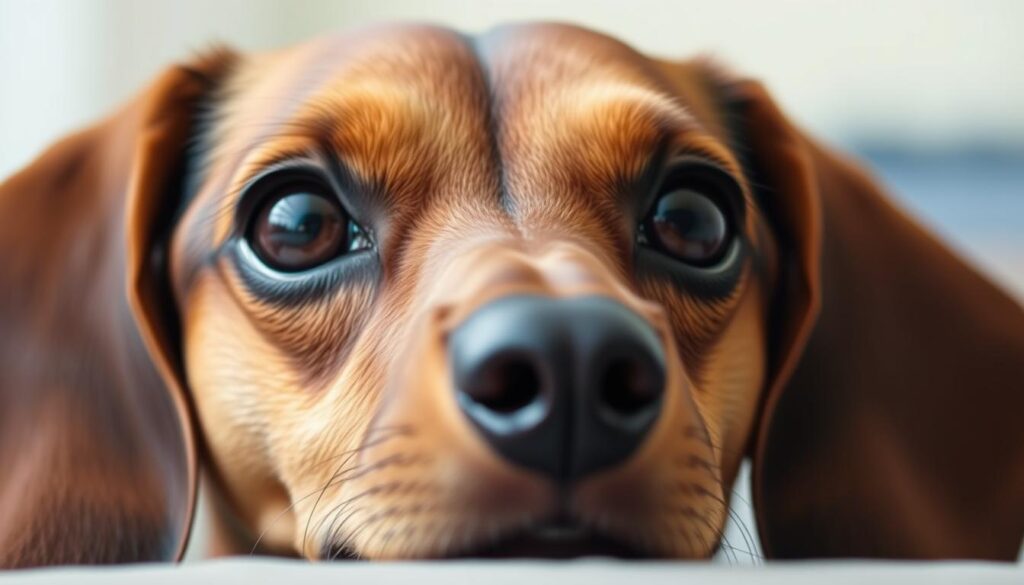
Muzzle and Nose
The dachshund head shape has an elongated muzzle that tapers gently towards the nose. This gives them a keen, inquisitive look. Their noses are usually black or brown, matching their coat color. Their long snout and strong jaw show their hunting heritage, helping them dig and chase prey.
Understanding these facial features helps us see why Dachshunds are so charming. Their expressive eyes, floppy ears, and long muzzles make their faces irresistible.
Muscular Build and Proportions
The dachshund physique is truly unique. These small dogs pack a powerful punch with their muscular build. Dachshunds have long, low bodies that are about 1.8 times their height at the withers. This distinctive shape gives them their famous “wiener dog” look.
Despite their short stature, dachshunds are surprisingly strong. Their dachshund muscular build allows them to dig and navigate tunnels with ease. Strong, well-muscled legs support their elongated bodies, enabling them to be effective hunters.
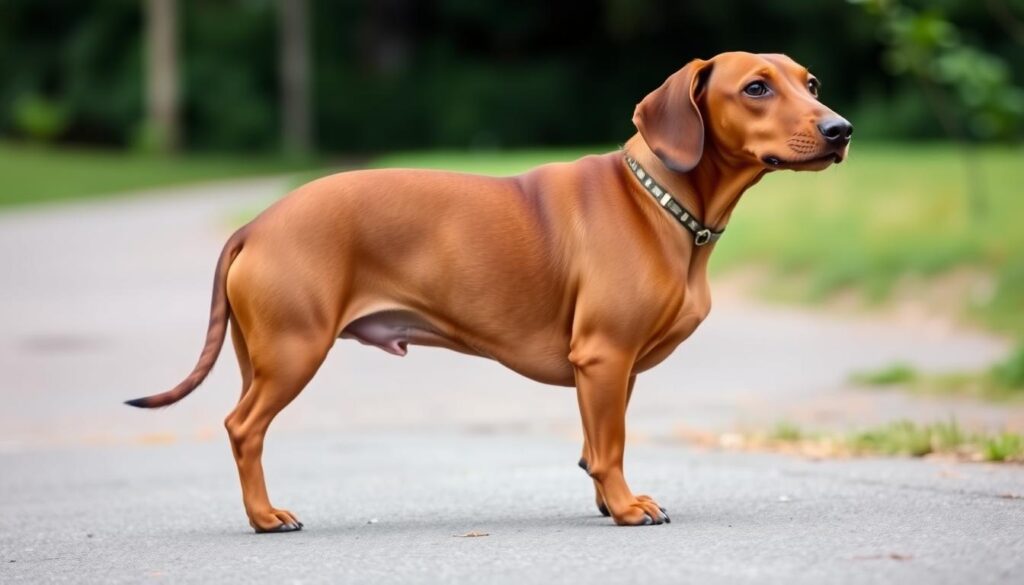
The dachshund proportions are carefully balanced. Their bodies should be compact yet powerful. A ratio of 2:1 for body length to height is ideal, with slightly shorter dogs preferred over longer ones. This structure supports their original purpose as badger hunters.
| Feature | Description |
|---|---|
| Body Length to Height Ratio | 1.8:1 (ideal) |
| Leg Strength | Well-muscled for digging |
| Chest | Deep, allowing lung capacity |
| Overall Build | Compact yet powerful |
The dachshund’s deep chest is another key aspect of their physique. It provides ample space for their heart and lungs, supporting their stamina during hunts. Combined with their strong forequarters and powerful jaw, dachshunds are built to work tirelessly all day long.
Weight Range and Body Condition
Knowing the dachshund weight range is key to keeping your pet healthy. A 2015 DachsLife Survey of 2000 dachshunds showed some interesting facts. Miniature dachshunds weighed an average of 5.8 kg, with 80% between 4-8 kg. Standard dachshunds averaged 10.9 kg, with 80% between 6 to 15 kg.
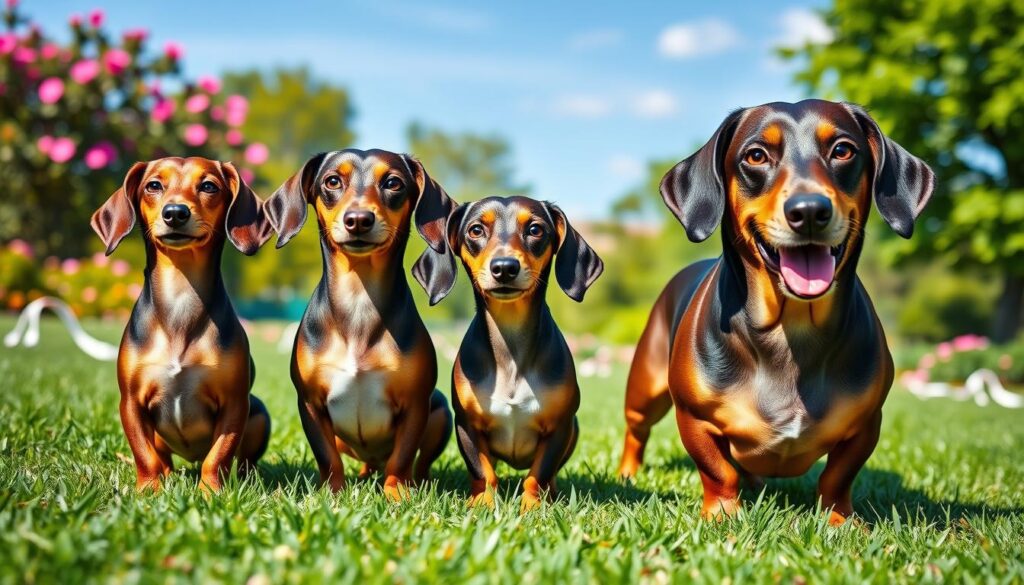
Ideal Weight for Standard Dachshunds
The Breed Standard says standard dachshunds should weigh 9-12 kg (20-26 lbs). This weight helps keep their body healthy and prevents health problems. Judges look for any signs of being too thin or undernourished to ensure the breed’s well-being.
Ideal Weight for Miniature Dachshunds
Miniature dachshunds should weigh around 4.5 kg (10 lbs), with a max of 5 kg (11 lbs). This size keeps their small stature while avoiding obesity-related health issues.
Importance of Maintaining Healthy Weight
Preventing dachshund obesity is crucial for their health. Their long spine makes them prone to Intervertebral Disc Disease (IVDD), which is worsened by extra weight. A balanced diet with high-quality animal protein, whole grains or veggies, fats, vitamins, and minerals is vital for their body condition.
| Dachshund Type | Ideal Weight Range | Average Weight |
|---|---|---|
| Standard | 9-12 kg (20-26 lbs) | 10.9 kg |
| Miniature | 4.5-5 kg (10-11 lbs) | 5.8 kg |
Dachshund Movement and Gait
The dachshund movement is truly captivating. These dogs have a special way of walking that’s both efficient and elegant. Despite their long bodies and short legs, they move with surprising ease and grace.
Their gait is unique, with the front legs moving forward in a smooth motion. Their hind legs then push them forward with great power. This allows them to move quickly and efficiently, whether they’re on land or underground.
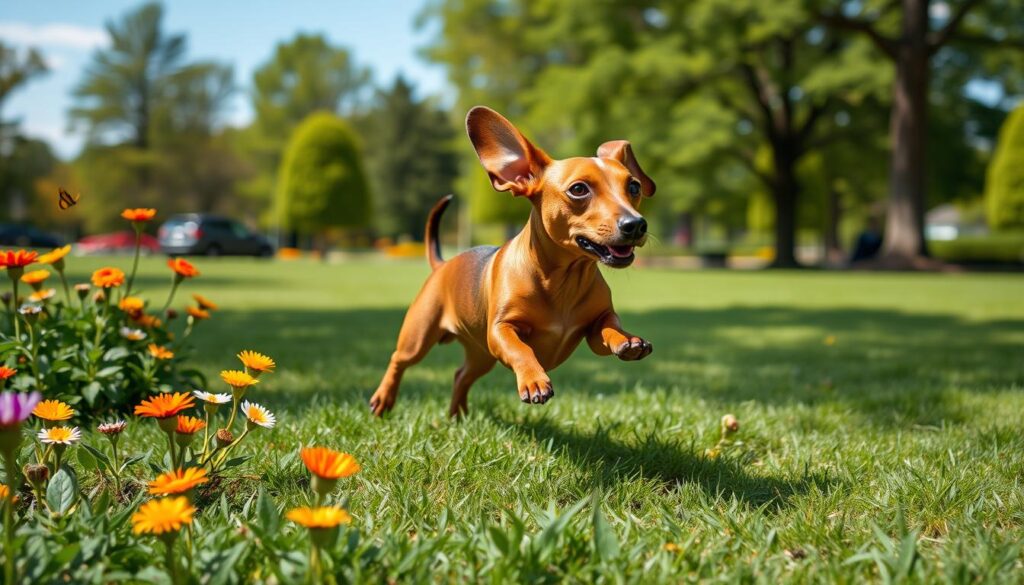
When watching a dachshund walk, you’ll see their front legs don’t always move in perfect lines. This is especially true when they’re moving fast. This slight variation is normal and helps them move better.
“The Dachshund’s movement should be fluid and smooth, with good reach in the forequarters and powerful drive in the hindquarters.”
Getting the movement right is key for dachshunds. Dogs with short legs or hips might walk stiffly. On the other hand, too long legs can make them move in an odd way.
| Aspect | Correct Movement | Incorrect Movement |
|---|---|---|
| Front Legs | Reach well forward | Short, restricted steps |
| Hind Legs | Powerful drive, equal reach | Weak push, uneven stride |
| Overall Gait | Fluid and smooth | Stilted or awkward |
Understanding how dachshunds move is important for breeders and owners. It shows their hunting background and adds to their charm and usefulness as a breed.
Genetic Health Considerations
Dachshunds are loved for their special looks, but their body shape can cause health problems. Knowing about these health issues is key to caring for your pet.
Intervertebral Disc Disease (IVDD)
IVDD is a big worry for dachshunds because of their long backs. It affects about 25% of them. Keeping your dachshund at a healthy weight and avoiding activities that hurt their back can help.
Patellar Luxation
Dachshunds are more likely to have patellar luxation because of their short legs. This is when the kneecap moves out of place. Seeing the vet regularly can catch this early, so it can be treated quickly.
Eye Conditions
Dachshunds can get eye problems like Progressive Retinal Atrophy and cataracts. It’s important to have their eyes checked often. This helps catch these issues early and keeps their vision good.
| Condition | Prevalence | Prevention/Management |
|---|---|---|
| IVDD | 25% of Dachshunds | Weight management, limited jumping |
| Patellar Luxation | Common in Miniatures | Regular vet check-ups |
| Eye Conditions | Varies by type | Annual eye exams |
Knowing about these health issues helps you take care of your dachshund. Regular vet visits and a healthy lifestyle are important. They help manage these problems well.
Grooming Needs Based on Coat Type
Dachshund grooming depends on their coat type. Keeping their coat clean and healthy is key. Let’s look at what grooming each coat type needs.
Smooth-coated Dachshunds have simple grooming needs. Use a rubber curry brush a few times a week to remove loose hair. Bathe them once a month to keep their coat shiny. They come in colors like red, black and tan, brown, fawn, and gray.
Long-haired Dachshunds need daily brushing to avoid matting. Use a slicker brush and greyhound comb for best results. Trim their fur often and bathe them monthly. They can be red, black, tan, or even have dappled patterns.
Wire-haired Dachshunds need special care. Their coats need stripping three to four times a year. Regular brushing and monthly baths are key. Some have a ‘pin wire’ coat that doesn’t need stripping.
| Coat Type | Brushing Frequency | Bathing Frequency | Special Care |
|---|---|---|---|
| Smooth | Every few days | Monthly | Use grooming mitt |
| Long-haired | Daily | Monthly | Regular trimming |
| Wire-haired | Weekly | Monthly | Stripping 3-4 times/year |
Brushing your Dachshund is more than just grooming. It’s a way to bond and check for skin problems. All Dachshunds need regular nail trimming, teeth brushing, and ear cleaning to stay healthy and happy.
Lifespan and Aging Process
Dachshunds live a long life, with an average of 12.5 years. This is 1.5 years more than most dogs. Some can even reach 16 years, making them great friends for a long time.
As your dachshund gets older, their health needs more attention. Over 20% of dachshunds die from old age. Cancer and heart disease also cause 17% and 14% of deaths, respectively. Taking good care of them as seniors is very important.
Dachshunds have a special body shape that can lead to health issues as they age. Intervertebral disc disease (IVDD) affects about 25% of them. This can cause paralysis in bad cases.
| Common Health Issues | Prevention Tips |
|---|---|
| Obesity | Proper diet and exercise |
| Skin problems | Regular grooming |
| Eye issues | Regular vet check-ups |
| Dental problems | Daily teeth brushing |
To keep your dachshund healthy, focus on prevention. This means a good diet, regular exercise, and vet visits. By doing these things, you can help your dachshund live a long, happy life with you.
Conclusion
Dachshunds are a beloved breed known for their unique traits. They have long bodies, short legs, and different coat types. These features make them charming and special.
As pets, dachshunds are loyal, playful, and affectionate. They make great companions for many families. Their charm and personality shine through.
It’s important to know their care needs when considering a dachshund as a pet. They need regular exercise and the right food. Long-haired and wire-haired dachshunds also need grooming.
Their long bodies can lead to health issues like intervertebral disc disease (IVDD). So, they need special care to stay healthy.
Dachshunds are not just about physical needs. They are smart and love to interact. With the right care, they can live 12-16 years.
By understanding and meeting their needs, you’ll have a loyal and spirited friend. Your dachshund will bring joy and love into your life.



